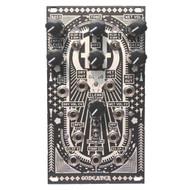Animal Factory — Godeater
by Andy Simmons
Animal Factory Amps founder Aditya Nandwana [Waveform #3], calls his Godeater module a “fuzztortion”, and it started out as a guitar pedal whose goal was to bring bass back into distortion, as distortion usually scoops bass out as it does its work. And by “bring bass back”, I mean it really, really brings bass back. Godeater is not a clone of any previous fuzz/boost/distortion circuit, but an entirely new makeup. I almost purchased the pedal a while ago, but I started hearing whisperings from Animal Factory about the Euro version and so I’ve waited for this day to come. After a couple years of waiting, we now have Godeater in the beloved Eurorack format that we all know and love so, so much.
Godeater’s internals consist of a level control paired with a high-pass filter at the input, which is then followed by two saturation and clipping stages, and a section for tone control. For tweaking the module's sound, you have several control elements at hand. Godeater has CV over almost every parameter, a wet and mix output, two three-way switches to select between diode and LED clipping, a high pass filter, a dedicated clean control, wet volume control, tone and bass control, crossfade switch, and a tone direction switch. The LED clipping is controlled by optocouplers in the circuit for a clean and fast response to what you are feeding it. Because of this, the module has an extremely clean character even when it’s outputting extreme dirt.
We all love quirks, and here is one in Godeater: Due to an error in engineering, for using CV, you should put negative CV into HPF for massive sub-bass and put positive CV through the input CV for some nice surprises. I found myself modulating Godeater a lot with the Nonlinearcircuits Triple Sloths. On occasion I would use a Soundmashines Light Strip inverted into HPF for sub-bass control, and I used it on all three songs in my release “The Boise Sessions.”
I’m partial to the LED clipping with Godeater. With the sources I use, the best way I could describe it is that with tone all the way to the left, it sounds like you’re in a jet turbine, as it sucks all the air out of the mix and screams. Using a Benjolin with the runglers going hard while Godeater is clipping creates a relentless, grinding and pounding sound, and you can add sub-bass to that to really thicken it up further. You can put more into it than just a normal mono signal, and I put “Tie a Yellow Ribbon Round The Ole Oak Tree” [Tony Orlando and Dawn] with my X1L3 monolith and also side-chained Godeater with the Coma reactor delay to see how that fared. It was devastating.
I’ve never heard a distortion that sounds so clean and defined. It makes it so much easier to mix into a track, though there are a couple of things I found curious with Godeater. Bass control is counter-clockwise. If you want more bass, turn it to the left. Have a manual ready for some of the switches like tone direction, which is a little ambiguous. Precision is key, as drastic character changes happen in an instant with the knobs; it can go from one distortion to another in no time, which caught me off guard more than a few times, and made it easy to lose that sweet spot you dialed in.
Even though it takes some dedication and practice to understand and master its quirks, Godeater was well worth the wait. The thing that AFA proves over and over again is that you can have extremely tunable gear and have it sound mean, not so mean, or anything in between. It’s this massive palette that means Godeater has plenty of secrets to discover.
14 HP +12V 35 mA -12V 25 mA
Price: $279


